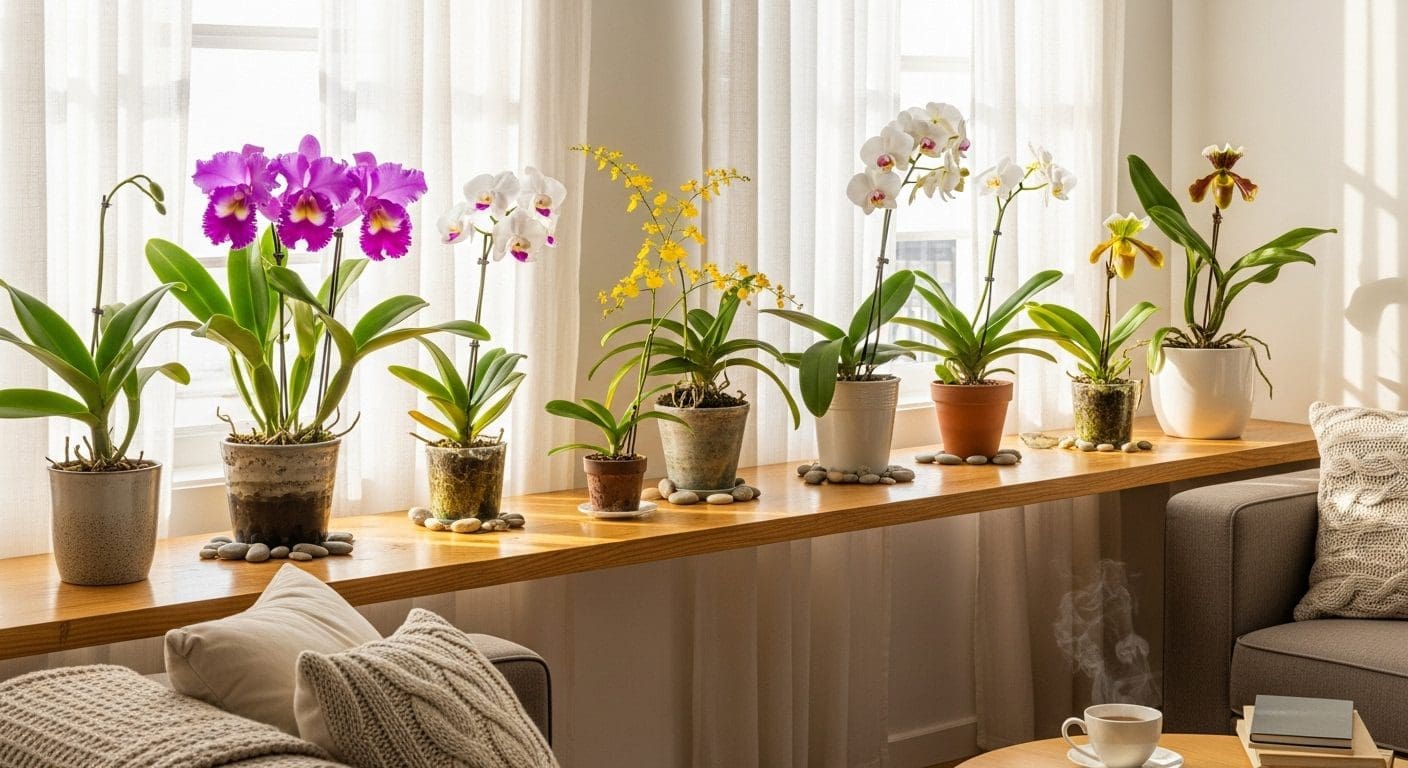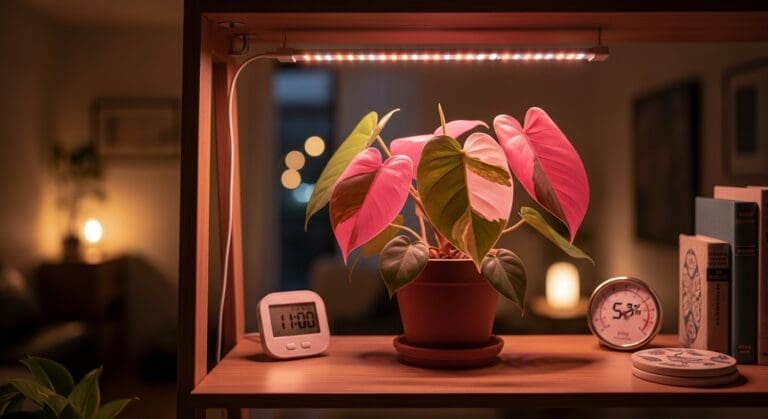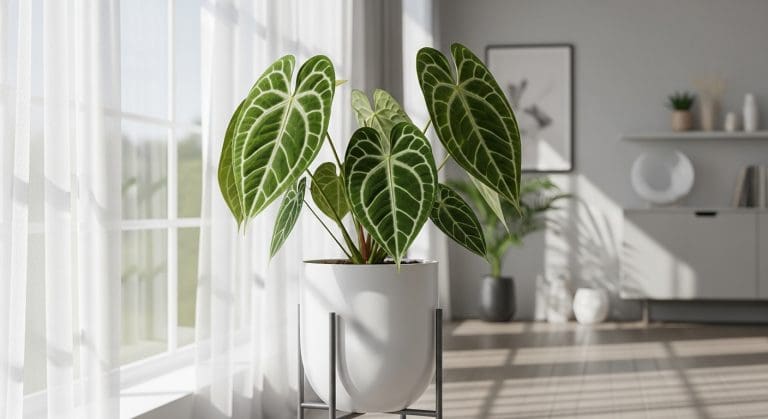“Every time a new bloom opens, I can’t help but pause and just admire it—they’re like tiny, living works of art.”
Rare tropical orchids can thrive indoors if you understand their specific needs. This guide walks you through light, watering, humidity, feeding, potting, and troubleshooting—everything you need to keep these plants healthy and blooming year-round.
Table of Contents
- Quick-Start Essentials
- Light for Rare Tropical Orchids Indoors
- Watering Fundamentals & The Calibration Method
- Humidity That Actually Works in Homes
- Potting Mix That Stays Evenly Moist (Peat-Free Recipe)
- Feeding Without Burn
- Repotting & Aftercare
- Propagation Options
- Seasonal Adjustments
- Troubleshooting — Symptom → Cause → Fix
- Gear That Helps (Quiet, Compact, Reliable)
- Mini Species Snapshots
- Expert Insight
- FAQs
Quick-Start Essentials
Think of orchids as tropical guests: they need bright but indirect light, evenly moist roots, consistent humidity around 60%, and a temperature range between 18–24°C. Pot them in a loose, airy mix that holds moisture without becoming soggy. Feed lightly but regularly. Repot every 1–2 years to refresh the mix.
Isn’t it satisfying when you find that perfect spot where a plant just thrives?
| Leaf-level target | Number | How to check |
|---|---|---|
| Humidity (RH) | ~60–70% at leaf height | Hygrometer at leaf height |
| Room-average RH (safety) | < 60% (EPA); < 65% in occupied spaces (ASHRAE) | Wall/room hygrometer |
| Temperature | 18–24°C days, slightly cooler nights | Digital thermometer near shelf |
| Light (at leaf) | See genus targets below (Phal ~10–20k LUX; Oncidium/Cattleya ~20–30k; Vanda 35k+) | Phone lux app at noon |
Sources: EPA (<60% RH), ASHRAE (<65% RH), and AOS culture sheets for light by genus.
Light for Rare Tropical Orchids Indoors
Orchids prefer bright, indirect light at the leaf. Practical indoor targets by genus are: Phalaenopsis ~10–20k LUX, Oncidium/Cattleya ~20–30k, and high-light Vanda 35k–50k+. These align with American Orchid Society foot-candle guidance (1,000–2,000 fc ≈ 10–20k lux for Phalaenopsis). Measure at leaf height with a phone lux app and adjust by leaf color and bloom response.
Sources: AOS Phalaenopsis/Oncidium culture notes; indoor window guidance.
- East-facing windows: Ideal; gentle morning sun.
- West-facing windows: Filter with a sheer curtain to soften intense afternoon rays.
- South-facing: Keep orchids a meter back or behind a light curtain.
For small flats, consider a narrow wall shelf just beside the window, avoiding direct midday sun.
| Genus (examples) | Home target (LUX) | Typical placement |
|---|---|---|
| Phalaenopsis, Paphiopedilum | ~10,000–20,000 | East window; shaded south/west |
| Oncidium, many Cattleya | ~20,000–30,000 | Bright east; south with sheer; back from glass |
| Vanda (high-light types) | ~35,000–50,000+ | Brightest spot; strong diffusion & airflow |
Source: AOS — Phalaenopsis, AOS — Oncidium, and AOS — Growing under lights.
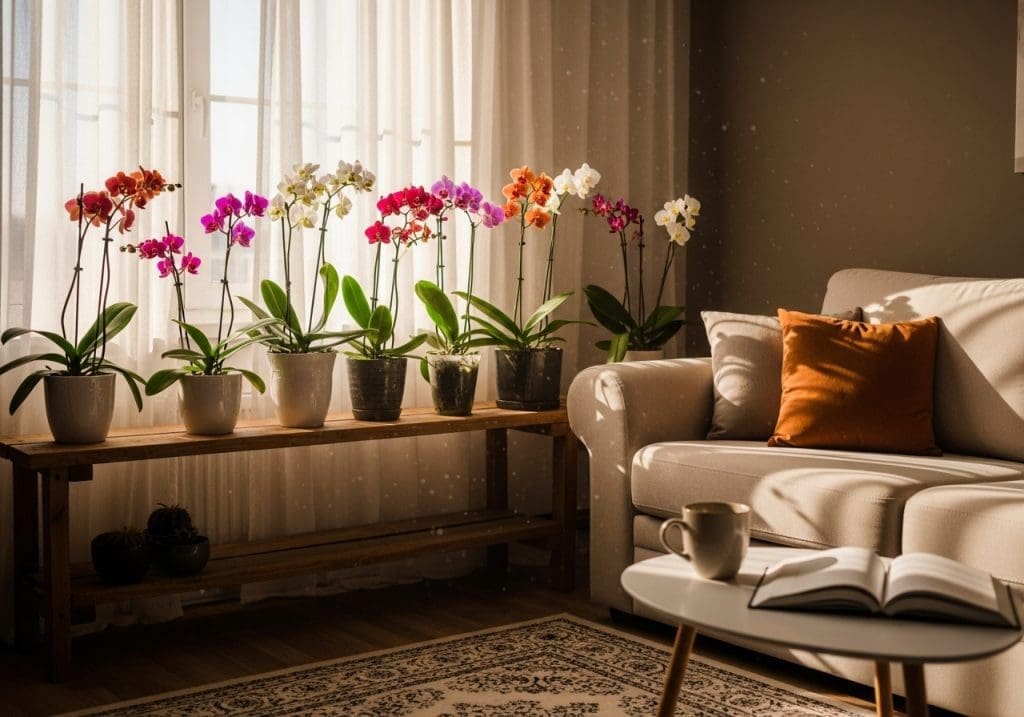
Watering Fundamentals & The Calibration Method
Orchid roots prefer consistent moisture but must also breathe. Use the finger test (top inch just starting to dry), lift the pot to feel its weight, or insert a wooden skewer to check deeper moisture.
Month-by-Month Watering Schedule (adjust for pot size, material, and humidity):
| Month | Small Plastic Pot | Large Plastic Pot | Small Clay Pot | Large Clay Pot |
|---|---|---|---|---|
| Jan-Feb | Every 10-12 days | Every 12-14 days | Every 7-9 days | Every 9-11 days |
| Mar-Apr | Every 8-10 days | Every 10-12 days | Every 6-8 days | Every 8-10 days |
| May-Jun | Every 6-8 days | Every 8-10 days | Every 4-6 days | Every 6-8 days |
| Jul-Aug | Every 5-7 days | Every 7-9 days | Every 4-5 days | Every 5-7 days |
| Sep-Oct | Every 6-8 days | Every 8-10 days | Every 5-6 days | Every 6-8 days |
| Nov-Dec | Every 9-11 days | Every 11-13 days | Every 7-8 days | Every 8-10 days |
Use this schedule as a starting point only—calibrate by pot weight, skewer test, and room RH/temperature; aim to keep mix moist but airy, never waterlogged.
Humidity That Actually Works in Homes
Orchids prefer 55–65% relative humidity. Grouping plants creates a microclimate; pebble trays help slightly, but humidifiers are most effective. Maintain a leaf-level target of ~60–70% RH with constant gentle airflow, but keep the room average under ~60% (EPA) and <65% in occupied spaces (ASHRAE) to reduce mold risk; ventilate if you see condensation.
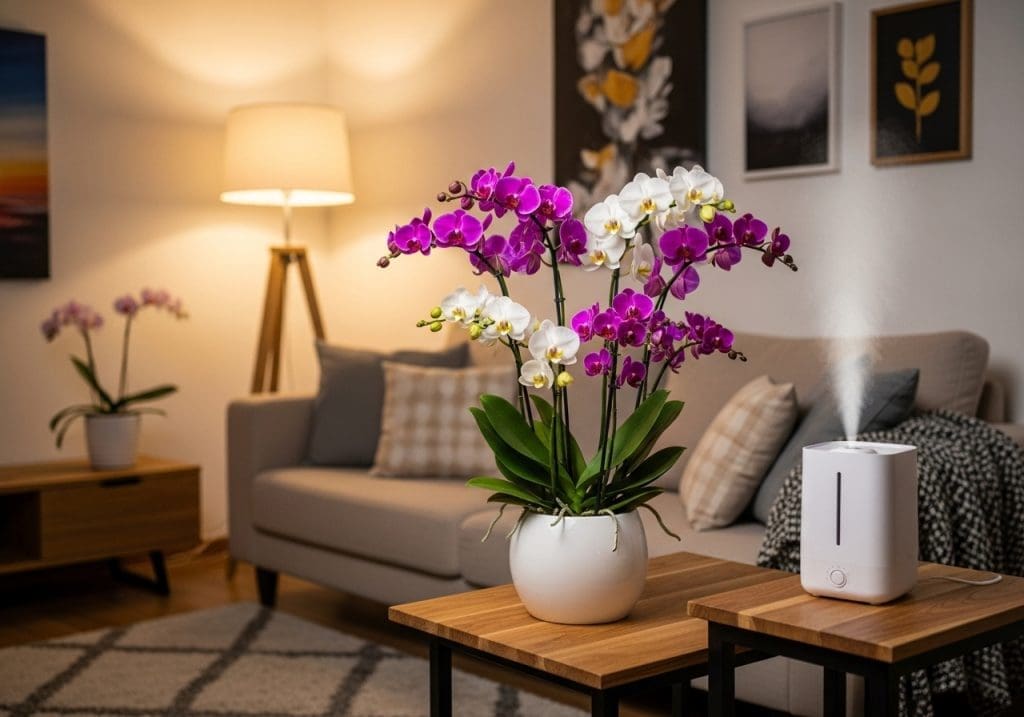
Potting Mix That Stays Evenly Moist (Peat-Free Recipe)
A balanced orchid mix:
- 40% fine/medium orchid bark (structure & airflow)
- 25% perlite or pumice (drainage)
- 20% coco chips/coir (even moisture)
- 10% horticultural charcoal (buffer)
- 5% long-fiber sphagnum (top-dressing optional)
Note: Keep it free-draining, bark-based; this aligns with RHS guidance for Oncidium/Cattleya types.
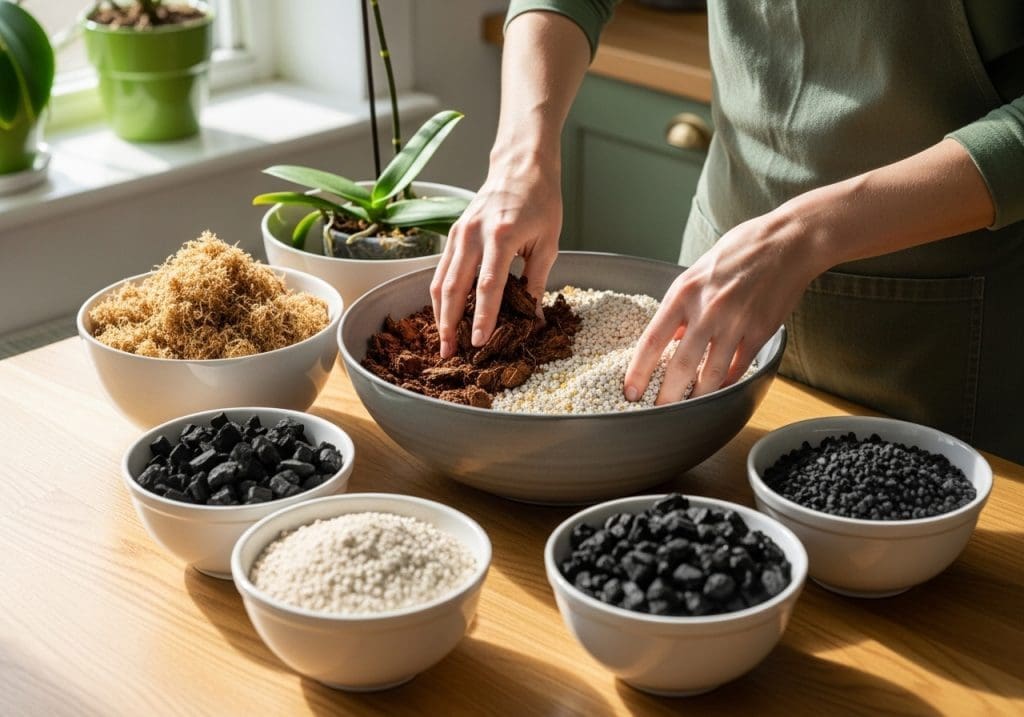
Feeding Without Burn
Use orchid fertilizer at ¼ to ½ strength every 2–3 weeks during active growth, ensuring you alternate between feedings and plain water to avoid over-fertilization. Once a month, flush the pot thoroughly with plain water to prevent salt build-up and keep roots healthy. Whenever possible, use rainwater or filtered water, as these help avoid mineral residue and maintain the delicate balance orchids need for sustained, vibrant growth.
Repotting & Aftercare
Repot every 1–2 years in spring to ensure the potting mix remains fresh and airy. When choosing a new pot, opt for one only 2–3 cm larger than the previous to prevent excessive moisture retention and root rot. Take the opportunity to inspect and trim any damaged roots, and settle the plant gently into its new mix. For mounted orchids, refresh and replace the moss at least once a year, ensuring it stays clean, evenly moist, and free from decay or pests.
Propagation Options
- Division: Separate healthy pseudobulbs, ensuring each division has at least three strong growths and healthy roots to support new growth. This method is best done during repotting, and each section should be potted individually in fresh medium.
- Keiki: Remove when roots are 5+ cm long and have at least two healthy leaves. Pot them in a small container with an appropriate orchid mix, keeping humidity slightly higher during the first few weeks to encourage establishment.
- Seed: Advanced; needs sterile lab-like setup, as orchid seeds lack stored nutrients. Germination requires a nutrient-rich agar medium and precise temperature and light control, making this method suitable for experienced growers or laboratory conditions.
Seasonal Adjustments
In winter, move closer to bright windows and water less. In summer, protect from harsh midday sun and water more often. “I love how orchids seem to sense the season change before I do.”
Troubleshooting — Symptom → Cause → Fix
| Symptom | Likely Cause | Quick Check | Fix |
| Yellowing leaves | Overwatering | Roots soggy? | Let dry, adjust schedule |
| Brown tips | Low humidity | Check RH with hygrometer | Increase humidity |
| Drooping | Underwatering | Pot light, mix dry | Water thoroughly |
| No blooms | Low light | If Phalaenopsis <10k LUX; Oncidium/Cattleya <20k; Vanda <35k | Move closer / diffuse sun / add LED. |
| Fungus gnats | Wet mix surface | See tiny flies | Let top dry, add sand |
Gear That Helps (Quiet, Compact, Reliable)
- Digital hygrometer
- Quiet ultrasonic humidifier
- LED grow light for winter
- Self-watering pots for consistent moisture
Mini Species Snapshots
- Phalaenopsis violacea: Easy, medium bright (not low), water weekly.
- Vanda coerulea: Very bright light, daily misting + strong airflow; avoid heat stress.
- Paphiopedilum rothschildianum: Bright for a Paph (multifloral type); keep evenly moist; cooler nights help.
Expert Insight
Orchids are adaptable, but they reward consistent light, moisture, and airflow—as summarized across AOS and RHS culture guides.
FAQs
Q: How often should I repot my orchid? Generally every 1–2 years, or sooner if you notice the potting mix breaking down, compacting, or developing a sour smell. Repotting not only refreshes the mix but also allows you to inspect and trim unhealthy roots, promoting stronger growth.
Q: Can I keep orchids in a bathroom? Yes, provided there’s enough light and good air circulation. Bathrooms with a bright, frosted window or a skylight can be ideal for humidity-loving orchids, but be sure to open the door or use an exhaust fan to prevent stagnant air.
Q: Why are my orchid’s leaves wrinkled? This is often a sign of underwatering, but it can also point to root damage that prevents proper water uptake. Check the roots for firmness and color—healthy ones are plump and green or silvery. Adjust your watering routine accordingly.
Q: Should I cut off old flower spikes? Yes, for most orchids, removing old spikes channels energy into new growth. However, with Phalaenopsis, you may choose to leave a healthy green spike for the possibility of a side branch and additional blooms.
Q: Do orchids need darkness at night? Absolutely—natural day/night cycles are essential for healthy growth and triggering blooms. Aim for at least 8–10 hours of darkness each night, avoiding bright artificial light that can disrupt their rest cycle.
Change log: Aug 2025 — Updated light targets by genus (AOS-based), corrected Paph. rothschildianum note, added Quick-Start targets with EPA/ASHRAE safety, refined bark-based mix.

RarePlantCare Editorial Team produces expert content on rare plants.
Our articles are AI-assisted and human-edited before publication.
We aim to provide practical, evidence-based guides for plant lovers worldwide.
Learn more about our Editorial Policy


